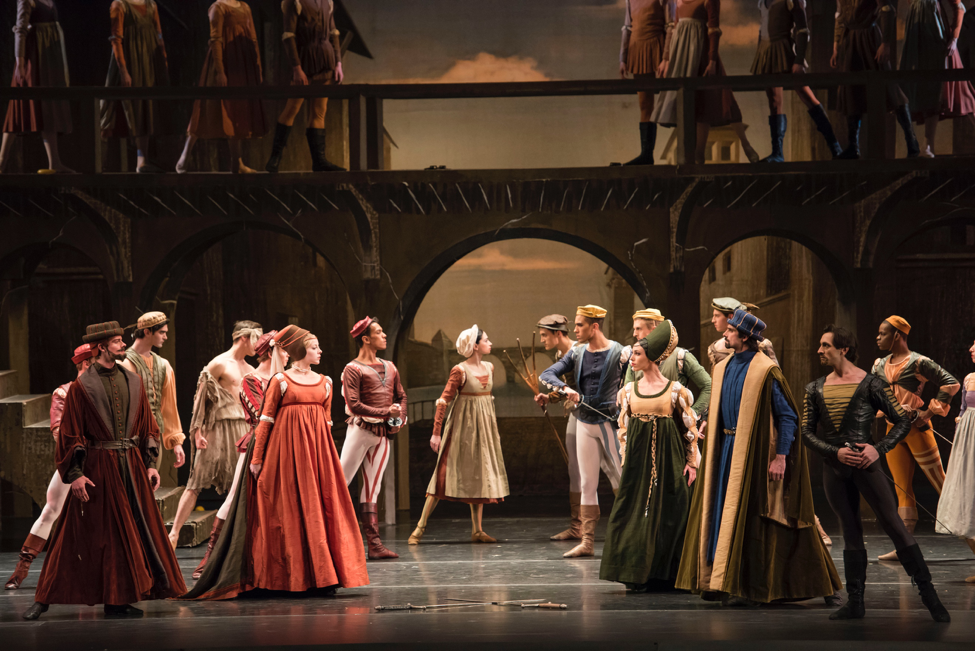A Timeless Classic: WHRB Classical Reviews the Boston Ballet’s Romeo and Juliet

The Montagues and Capulets face off in the marketplace. Photo courtesy of Boston Ballet.
There are few stories as universally beloved and unceasingly retold as Shakespeare’s Romeo and Juliet. On April 7, the Boston Ballet brought the two young lovers to life (and then death) in a production set to Sergei Prokofiev’s iconic score and choreographed by John Cranko.
A whimsically chaotic marketplace scene – which involved some playful fruit-throwing – established the rift between the Montagues and Capulets early on. It was helped not only by the clear-cut left-right division onstage, but also by the color contrast of their costumes. Indeed, the scenic and costume designs, created by Jürgen Rose in 1968, were absolutely exquisite; each piece was intricate but not distracting, classic but still interesting.
Anaïs Chalendard, who played Juliet on April 7, accentuated Juliet’s youthfulness above all else in the first act of the show. When her mother gifted her with a dress for the masquerade ball, she reacted as a child would on Christmas morning. And at the ball itself, it was clear that Paris could not keep up with her boundless childlike energy. Interestingly, Juliet became more and more mature over the course of the ballet, as if love had aged her. As Romeo, Eris Nezha was technically brilliant and did a fine job of supporting Juliet. The pair had a delicate chemistry throughout the first two acts, but sparks did not truly begin to fly until the bedroom pas de deux in the first scene of the third act. The heartbreak of farewell heightened the tension just enough that Romeo and Juliet’s love became something more than youthful infatuation.
The star of the show was, however, neither Romeo nor Juliet. Instead, it was Mercutio, danced by John Lam at the April 7 performance, who stole the audience’s hearts. If Romeo was lost in the haze of his love, Mercutio was the epitome of sharp sarcasm and wit. While energetic and playful to the extreme, John Lam succeeded in grounding Mercutio in a reality that Romeo was unable to access. The finest example of Lam’s acting prowess was Mercutio’s death scene. The look of absolute shock on Mercutio’s face when he realized that Tybalt had wounded him fatally was certainly a departure from the carefree and mischievous Mercutio of the entire first act. For the first time, he was vulnerable -- and it was heartbreaking. No sooner had he registered the grim truth of his injury than he returned to his marauding ways for one last (or maybe two, or three) dance with the ladies.
It is interesting to note that Prokofiev’s ballet does not include the final scene of the play, which sees the reconciliation of the Montagues and Capulets in the wake of their children’s deaths. The omission, though outside the scope of the Boston Ballet’s responsibilities as performers, seems odd, considering the way much of the first two acts hinge on the rivalry between the two families. Nevertheless, the Boston Ballet gave a solid and emotional performance of a timeless classic.
Karissa Huang '21 and Joyce Lu '21 are producers for WHRB Classical. You can hear classical music on WHRB on Mondays - Fridays 1pm - 10 pm, Saturdays 1pm - 9pm, and Sundays 2pm - midnight.